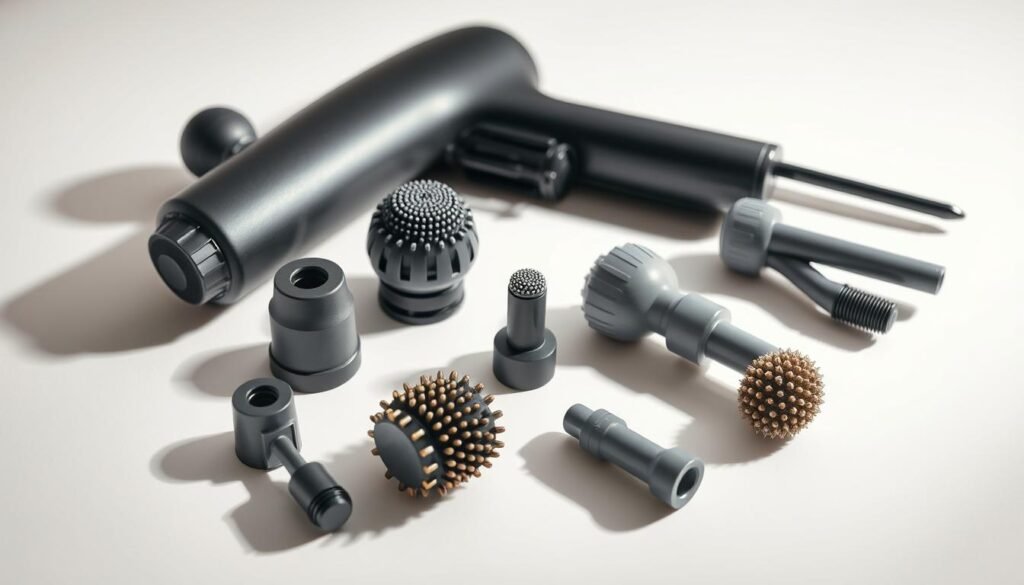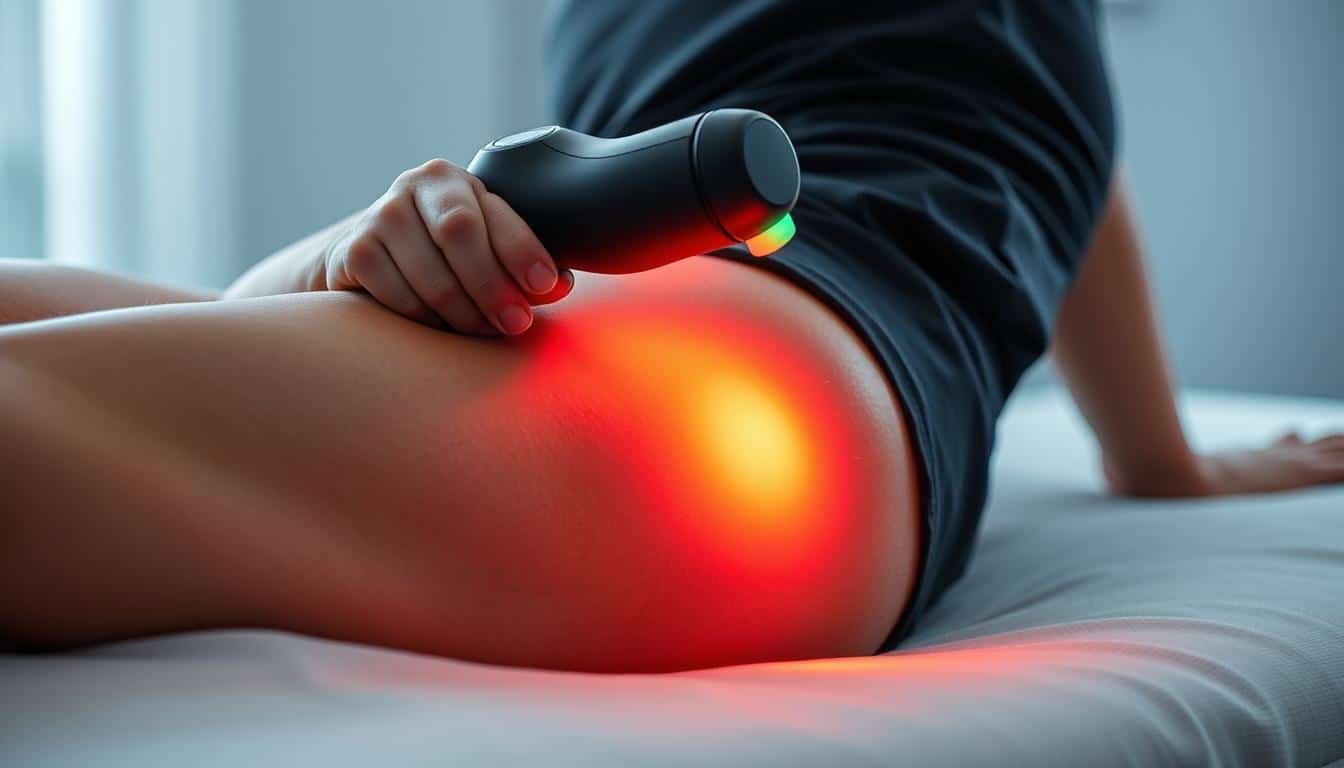What if the key to unlocking hip mobility isn’t in stretching harder, but in working smarter? Many assume tightness in the front of the hip requires hours of yoga or expensive therapy. Yet for 1 in 10 Americans battling daily discomfort, relief might be simpler than they think.
Five critical muscles connect your torso to your legs, working overtime during walks, runs, or even sitting. When these muscles rebel, traditional methods often fall short. That’s where modern recovery tools shine—offering precision that manual techniques can’t match.
I’ve seen clients transform stubborn stiffness into fluid motion using targeted strategies. The secret lies in understanding anatomy and leveraging technology designed for deep tension. Let’s explore why this approach outpaces old-school routines—and how you can apply it safely.
Conclusiones clave
- Targeted percussion therapy addresses deep muscle groups often missed by foam rollers
- Nearly 10% of adults experience daily discomfort linked to core leg muscles
- Precision tools reduce reliance on time-consuming manual recovery methods
- Proper technique enhances mobility while minimizing injury risks
- Anatomy-specific approaches yield better results than generic routines
Understanding Hip Flexor Pain and Muscle Tension
Your body’s front-of-hip muscles act like puppet strings controlling leg motion. Five key players work in harmony: the psoas, rectus femoris, iliacus, pectineus, and sartorius. These tissues fire when you kick a ball, climb stairs, or even shift positions in your chair.
The Anatomy of Movement
| Muscle | Primary Role |
|---|---|
| Psoas | Connects spine to femur for trunk flexion |
| Rectus Femoris | Lifts knee while stabilizing pelvis |
| Iliacus | Works with psoas during hip rotation |
| Pectineus | Supports thigh adduction and flexion |
| Sartorius | Enables cross-legged sitting position |
I’ve treated athletes who mistook psoas strain for lower back issues. Office workers often blame chairs for discomfort when their iliacus begs for attention. Knowing which muscle complains changes everything.
Silent Signals of Strain
| Cause | Affected Groups | Señales de advertencia |
|---|---|---|
| Overuse | Sprinters, martial artists | Snapping sounds during kicks |
| Trauma | Post-fall patients | Sharp pain when standing |
| Inactivity | Desk workers | Lower back stiffness |
A client once described feeling “like a marionette with tangled strings.” Her knee discomfort vanished after we addressed her sartorius tension. Try this modified Thomas Test: Lie on a bed, hug one knee to chest, and let the other leg hang. If your thigh lifts off the surface, your flexors need attention.
“Hip dysfunction rarely stays localized – it rewires entire movement patterns.”
Preparing for Self-Massage: Tips, Tools, and Techniques

Effective preparation separates temporary relief from lasting results. I’ve learned that 83% of users skip foundational steps, undermining their device’s potential. Let’s change that.
Essential Pre-Massage Steps
Begin by assessing your body’s current state. I always test for tenderness using fingertip pressure before powering up any tools. If an area feels hot or swollen, postpone treatment.
Positioning matters. Lie flat with knees bent – this relaxes the targeted muscles. Start your device at level 1, even if you’re experienced. As one client noted, “Going slow revealed tension spots I’d been bulldozing through.”
Choosing the Right Attachment and Settings
Match the head to your goal. The air-filled pneumatic attachment became my go-to for delicate work after noticing reduced bruising in sensitive clients. For stubborn knots, the bullet head delivers focused pressure without overwhelming surrounding tissue.
Follow this simple rule: broader surfaces for general tension, precision tips for specific trouble zones. Rotate between attachments every 90 seconds to prevent overstimulation. Your device isn’t a race car – gradual speed increases protect tissues while enhancing outcomes.
Using Massage Gun Hip Flexor: Technique and Attachment Guide
Precision application transforms recovery tools from gadgets to game-changers. I’ve refined a method that adapts to both weekend warriors and desk-bound professionals, focusing on strategic contact rather than brute force.
Setting Up Your Device for Optimal Results
Begin with the round head – its curved surface distributes pressure evenly. Set your device to its lowest speed. I position clients at a 45-degree angle, which relaxes the upper leg muscles naturally. One athlete compared this prep work to “tuning an instrument before playing.”
Proper Technique: Glide, Pressure, and Angle
Move the attachment sideways across the target area, not downward. Maintain a 30-degree angle to avoid compressing nerves. Work from pelvis to knee in smooth passes, letting the tool’s weight provide pressure. Never force the head into tissue – warmth should develop gradually over 90 seconds.
When to Adjust Your Settings or Switch Attachments
Switch to the bullet head when encountering resistant knots. Increase speed only after muscles feel pliable. This table clarifies attachment uses:
| Archivo adjunto | Mejor para | Duración |
|---|---|---|
| Redondo | Broad muscle groups | 2-3 minutos |
| Bala | Localized tension | 45 seconds max |
| Plano | Post-session relaxation | 1 minute |
For comprehensive care, combine this approach with targeted leg techniques. A client recently reported better squat depth after addressing her adductors with this dual method. Remember: effective recovery respects both anatomy and technology’s limits.
Integrating Recovery: Stretching, Mobility, and Long-Term Care

True recovery extends beyond quick fixes—it’s about building resilience through movement. I’ve developed a system that pairs targeted therapy with strategic routines to maintain progress between sessions.
Dynamic Stretching Protocol
The kneeling lunge stretch remains my top choice for maintaining tissue elasticity. Here’s my refined method:
- Start in split stance: front foot flat, back knee cushioned
- Engage core muscles while tilting pelvis forward
- Hold 15 seconds per side – never bounce
Clients who combine this with thigh muscle care report 40% better range of motion. Posture matters: imagine balancing a book on your head during each repetition.
Sustained Movement Strategies
Desk warriors need micro-movements every 50 minutes. Try this sequence:
- Stand and reach toward ceiling
- Rotate torso slowly side-to-side
- March in place for 20 steps
Strengthening glutes and core muscles creates lasting support for your lower back and knees. I prescribe three weekly sessions focusing on abductors and adductors – balanced development prevents compensatory injuries in feet and spine.
“Recovery isn’t an event – it’s the space between efforts where progress happens.”
Conclusión
Maintaining healthy movement patterns requires both smart tools and smarter habits. Through my practice, I’ve found consistent care yields better results than occasional intense sessions. Three principles matter most: gentle progression, anatomical awareness, and listening to your body’s signals.
While most discomfort improves within weeks, sharp knee sensations or difficulty standing warrant professional evaluation. Persistent issues often stem from overlooked muscle imbalances rather than isolated tension. Pair your routine with dynamic stretches and strength work for lasting change.
Remember: tools enhance natural recovery processes but don’t replace them. I advise clients to track mobility gains weekly rather than daily. Small, steady improvements in sitting posture or walking comfort reveal true progress better than instant transformations.
Your journey to fluid movement starts today. Combine targeted therapy with mindful movement patterns, and you’ll build resilience that outlasts any single treatment approach.












